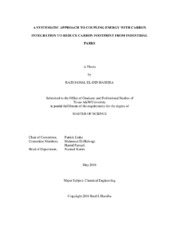| dc.description.abstract | The depletion of natural resources and the increase in greenhouse gases emissions, which constitute mainly from carbon dioxide, has led many policymakers to issue policies to reduce carbon emissions and fuel consumption. However, reducing the energy consumption is constrained by meeting the increase in goods demands governed by the growth in global population. This problem can be tackled by improving process efficiencies which leads to a decrease in fuel consumption and hence the emissions. Moreover, end-of-pipe treatment approaches reduce carbon emissions by capturing carbon dioxide and store it or utilize it. While the first method is achieved via heat integration, the second method is achieved through carbon integration. In the first method, heat is exchanged between processes to minimize fuel consumption whereas the additional low grade heat is removed using cooling utilities. Moreover, carbon integration requires heat and power to capture and ship carbon dioxide from sources to sinks. This introduces a potential for synergy, where excess heat is used in the capture unit. This work explores this potential via two approaches: sequential and simultaneous. In the first approach, the energy and carbon integration are applied separately to minimize fuel consumption and carbon dioxide emissions. Afterwards, the excess waste heat is utilized to partially or fully offset the carbon integration heat and power demand, resulting in additional savings and further carbon reduction. This approach was demonstrated through a case study, where substantial savings were realized. In the second approach, the energy and the carbon problems were implemented simultaneously through an MINLP model. The same case study was used in order to demonstrate the further benefits that can be obtained from solving the problems simultaneously. | en |


